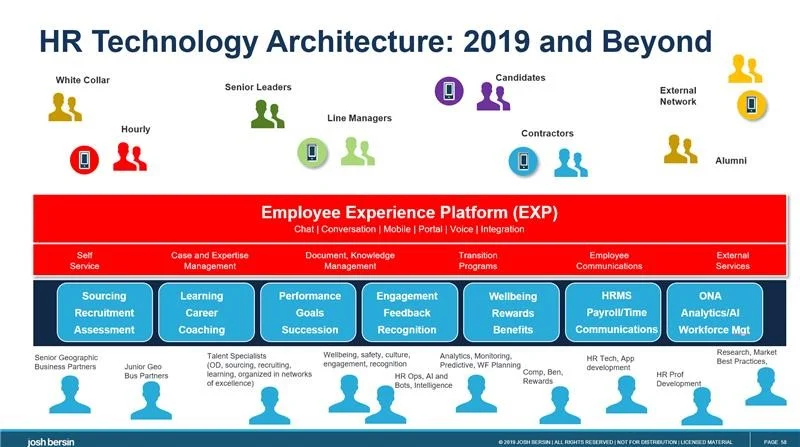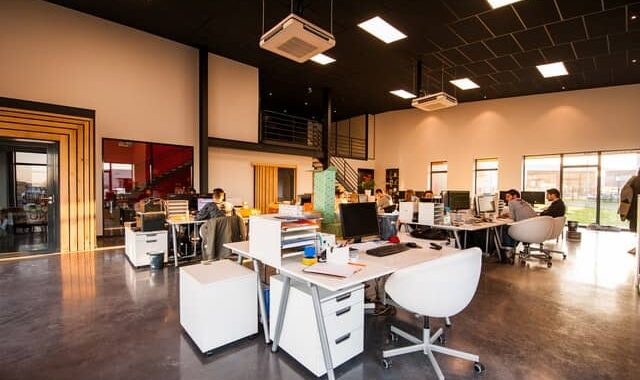
Today, it may seem that digital transformation is at the heart of HR management. But it’s the employee experience that can really make or break a company. Although HR software can take a burden off of the HR function, this large wave of digitization may have taken over the HR field without thinking enough about the employee experience.
Instead of abandoning technology altogether, companies need to leverage human-centric platforms to improve employee retention, motivation, and engagement.
Employees who report a positive employee experience are 60% more likely to stay at the company, 69% more likely to be high performers, and 52% more likely to go above and beyond their day-to-day responsibilities according to Gartner.
Related articles:
Digital Leadership in HR: Transform your Management System
5 Key Tools to Have in Your Human Resource App
What is Employee Experience?
Employee experience refers to the experience a worker has at a company during their employee life cycle. The employee experience covers the entire journey of an employee and includes everything within the workplace experience, which includes everything from surroundings, people, systems. We have a detailed article if you want to learn more about the importance of a positive workplace experience.
Employee experience has become more popular in recent years as we see in the Gartner Survey and should be considered one of the main priorities for the HR department as it is directly correlated with the success of the company. In this study, we can see that 47% of HR leaders are prioritizing employee experience as a key initiative.
If you haven’t already, your HR department should implement HR strategies to improve your workforce experience. Examples of strategies to consider to improve your employee experience includes:
1. Treat your employees as customers
2. Provide collaboration tools
3. Encourage cross-functional teamwork
4. Collect feedback from employees
5. Provide training and development opportunities
After implementing the strategies, employee experience can be managed and monitored through multiple different subcategories:
Employee Engagement
Employee engagement is closely related to the employee experience. But pay attention to the fact that there is a distinguishing difference between employee experience versus employee engagement. Employee engagement is the employees’ commitment to their company, whereas employee experience refers to what the employees observe and appoint at a company.
The more engaged your employees are, the more likely it is that they will have a positive employee experience. This is true the other way around as well. If an employee has a positive employee experience, they are more likely to engage in their work. If you are an HR manager, you should think of HR strategies that can drive your employee engagement. This can include:
1. Recognize and compensate your employees
2. Invest in employee enablement and training
3. Dynamically seek employee feedback
4. Help your employees to become better acquainted with each other
5. Encourage flexibility
When implementing changes to increase employee engagement, consider touching every part of the employee life cycle. The employee life cycle is the journey an employee makes through a company, from start to finish. This includes attraction, recruitment, onboarding, career development, and offboarding. If the employee is engaged throughout their entire life cycle, they are more likely to have a positive employee experience.
Employee Motivation
As you’ve probably gathered, employee motivation is an important part of the employee experience. If your employees feel motivated at work, they are more likely to have a better employee experience. As an HR professional, it is important that you are engaged with your workforce and motivate your employees. However, this can be easier said than done.
Abraham Maslow’s hierarchy of needs identified 5 main categories of needs that a consumer has: physiological, safety, love/belonging, esteem, and self-actualization. The same goes for your employees. When looking for drivers to motivate your employees, consider their survival instinct, security and comfort, belonging, and self-actualization.
After identifying the motivators of your employees, it is in your hands to inspire and motivate them. Although each individual should be managed differently depending on their motivators, there are some main points that have been identified to motivate employees. When looking for things to do to motivate and retain your employees, you can start with the easiest. What does their salary look like? Make sure that you are rewarding your employees and paying them well.
You can implement tactics like gamification at work to motivate employees. This approach can help employees become more productive and engaged. It can be applied at any point of the employee journey such as recruitment, onboarding, training, or performance management.
Have an open communication channel with everyone, from top to bottom, to make sure that no one feels out of the loop and that they feel like they are at a good, fair workplace. It is important that everyone feels like they are a part of the company.
Retention Rate
If your employees are having a negative employee experience, you might find yourself losing employees. Or worse, your organization might experience quiet quitting which is a form of disengaging without leaving the company.
It is important to retain employees for multiple reasons, such as keeping top talent and retaining a positive employer brand. Organizations with higher employee turnover can get a negative reputation of being difficult to work with. Employee retention is also an essential HR metric and can be used to measure your company’s internal success. With a higher retention rate, you also save money on expensive recruitment and employee training programs.
In most cases, a retention rate of 90% is considered good. If you are having a lower retention rate than that, there are multiple employee retention strategies you can apply to your business. Effective employee retention strategies should touch multiple parts of the employee life cycle. Below are some ideas to get you started:
- Optimize the onboarding process
- Provide workplace perks
- Compensate employees fairly
- Focus on employee wellness
- Monitor risk factors for burnout
- Implement feedback and surveys
- Virtual suggestion box
- Offer growth opportunities
- Transparent communication
- Involve employees in decision-making
- Encourage work-life balance
- Hire for culture fit
- Create a mobile-friendly workplace
- Implement a recognition program
Employee Happiness
Never ignore your employee’s happiness. If you have happy employees, this will be reflected in your business and you will be more likely to reach your business goals. Happiness at work means different things to everyone. Managers are responsible for getting to know their employees to understand what is important for them in order to be happy.
Start by getting to know your employees’ goals. One way to do this is by implementing one to one meetings. Discuss with them how together, you can seek to evolve and improve them over time. Make sure that you accept failure and know how to challenge them and support their exploration in engaging all possibilities of success.
How to disconnect from work
In order to have happy employees, also monitor your employees’ ability to maintain a good work-life balance. The balance between work and life can be a thin line. For example, are you checking your e-mail after your work day is finished? If you are, you are mixing your professional life and personal life. As an HR manager, you should promote the ability to disconnect from work as it leads to an improved employee experience. If you are noticing that your employees feel stressed at work, encourage them to focus on their private life a little bit more and disconnect from work. There are multiple ways to do that, for example:
1. Establish boundaries and say no when it is too much
2. Manage technology and switch off electronic devices
3. Spend time alone
4. Learn something new
5. Take a full vacation
However, not all organizations have employees that are struggling to have a work-life balance, but rather are facing challenges in responding to personal constraints of employees. As an manager, it is important to always recognize that your employees have a life outside of work. If this is your situation, we have an article that explains how to respond to personal constraints of employees.
Work Environment
Do you have a good work environment at your workplace? Do people get along? A good work environment is positively correlated with a good employee experience. Although all HR teams work for a positive work environment, this is not always the case. Especially in bigger workplaces, friction can appear as not everyone always gets along. It is important that the HR department is educated on how to support their employees to work well with different personality types. As an HR leader, there are four main personality types you can look out for:
1. Direct communicator
2. Creative individual
3. People pleaser
4. System follower
Each personality type functions and communicates differently and needs to be managed accordingly. If you experience friction in your workplace, your HR department should employ employee training programs to train managers and supervisors on how to manage different employees and personality types.
When analyzing and implementing positive changes to your work environment, also consider demographical differences between your employees. It is important to know how to manage a multigenerational workforce, considering that there will soon be five generations of workers in the American workforce: Veterans, Baby boomers, Generation X, Generation Y, and Generation Z. Each group brings distinct attributes, work ethics, and values to the workplace.
Often so, managers neglect the differences between generations and might struggle especially with managing and supervising their younger employees as they do not act and communicate the same way as older generations. If you are struggling to manage younger generations at your workplace, we have an in-depth article on understanding and managing Generation Z.
How to Improve Employee Experience in Your Organization
Improving employee experience is not just about perks or flashy benefits. It’s about creating an environment where people feel supported, trusted, and motivated to give their best. The most effective organizations understand that employee experience is built through intentional actions, clear communication, and a culture that puts people first.
Focus on Leadership and Manager Impact
A strong employee experience begins with leadership. Managers play a central role in shaping day-to-day culture, which means their approach directly influences how people feel at work. When leaders act more like coaches than supervisors, employees are more likely to feel supported and stay engaged.
Some simple ways to support better leadership include:
- Providing regular leadership coaching and feedback
- Encouraging one-on-one check-ins focused on personal and professional goals
- Giving managers the tools to recognize and address burnout before it escalates
Simplify Processes and Remove Friction
Every interaction an employee has with your systems or processes affects their overall experience. If requesting time off, submitting expenses, or accessing training feels complicated, it adds unnecessary frustration. Streamlining these touchpoints can significantly reduce stress and improve satisfaction.
Focus your efforts on:
- Making HR systems easy to use and mobile-friendly
- Centralizing communication and task management
- Removing unnecessary layers of approval that slow things down
Employees should be able to focus on their work, not on navigating bureaucracy.
Create a Culture of Recognition
Feeling appreciated is a powerful driver of engagement. Recognition does not need to be elaborate or costly. What matters is that it feels sincere and consistent. Whether it’s a quick thank-you message or a formal shout-out in a meeting, acknowledging effort builds morale.
To build a recognition culture:
- Train managers to regularly acknowledge contributions
- Encourage peer-to-peer recognition
- Celebrate wins, both big and small, as a team
Recognition helps people feel seen and valued, which in turn strengthens connection and loyalty.
Support Growth and Development
People want to grow. When employees feel like they’re stuck or not learning anything new, motivation fades. Offering clear development paths and regular opportunities to gain new skills shows that you’re invested in their future.
Ways to promote development include:
- Offering stretch assignments or internal mobility options
- Holding quarterly development check-ins
- Providing access to learning platforms or mentorship programs
Investing in your people’s growth helps them (and your organization) thrive.
Prioritize Well-Being and Flexibility
Workplace well-being is about more than just free snacks or yoga sessions. It’s about creating a culture that respects boundaries, encourages balance, and supports mental health. Flexible working arrangements can also have a major impact on how employees experience their day-to-day.
What you can implement:
- Flexible hours or hybrid work models
- Mental health days or dedicated wellness resources
- Clear workload expectations that respect personal time
When people feel trusted to manage their time and supported when things get hard, they’re more likely to stay committed and energized.
Measure Employee Experience Using Surveys
Surveying is helpful in many parts of business, neitherless for the employee experience. In order to measure and find way to improve your workforce experience, implement employee experience surveys. You can choose between surveying your employees on every other year, annually, or through continuous feedback, depending on your employees’ needs.
When creating employee experience surveys, there are a few things to keep in mind. To start with, make sure that the language are clear so your employees don’t get confused on what it is that you are trying to ask. Ensure that your employees feel comfortable answering the questions, anonymity can help with that. When forming the questions, consider how each question is relevant to your company. Don’t waste your employees’ time with irrelevant questions.
The Employee Experience Platform
HR managers rely on HR technology to manage employee experiences. Based on a PwC HR Tech Survey in 2022, 84% chief human resource officers reported that they saw an increase in employee engagement after the integration of core HR on cloud.
However, there is a numerous amount of HR software available on the market, which makes managing, tracking, and evaluating complicated for the HR department. The lack of connectivity between HR technologies leads to a lack of attention to the employee experience, which is particularly harmful since it does not contribute to the employee’s well-being and quality of work life. Even worse, disoriented by this abundance of tools, the employee may quickly disengage, and finally not use the software, thus creating additional friction between the HR and employees.
We can clearly outline the original problem: the lack of connectivity between the different HR software and the absence of a single, simple, and user-friendly platform from which the employee can quickly and easily access all the available modules. This also creates disorganization and decrease workforce business development. According to a Sapient study in 2021, there has been many changes in HR from organizations replacing HR paper-based processes, 3% increase, to noticing that HR technology influences workforce business development, comparing to 2020. This is why there is a shift now to focus more on organization to improve the employee experience.
1. A platform dedicated to a “collaborative experience”
The Employee Experience Platform are essentially an employee portal that addresses the following questions: What are the ways to improve employee productivity and employee engagement? How can we offer an efficient tool to the employee so that they can easily navigate between different HR software?
The EXP presents itself as the ideal tool. It is a unique and easy-to-use platform that connects all your existing HR software. Thanks to its open architecture, this connective platform allows the employee to have quick access to all the HR software of the company. The navigation between the company’s different HR modules is no longer constraining. From the EXP platform, the employee can access all the information they need.
For example, the employee can, in a few clicks, request vacation, consult their schedule, or even submit expense reports. In reality, this idea comes directly from HR experts because they were the first to understand that as long as HR software doesn’t communicate with each other, employees won’t be comfortable using it. Thus, rather than focusing on the performance of the different software, the EXP is “employee-focused” and puts emphasis on its accessibility for the employee. It’s a platform that attempts to simplify daily tasks and optimize internal communications.
2. Reflecting your employer brand
Moreover, by favoring the employee experience, the EXP naturally enhances the company’s employer brand since it also promotes the employee’s well-being. For example, the onboarding process is sometimes a painful process for the new employee because he or she is overwhelmed by the multitude of new information.
However, this experience is fundamental because it often determines how the employee will feel in the company. We want our new recruits and employees to feel highly motivated and well-engaged. Therefore, providing them with a well-designed platform on which they can rely, access their personal space, and find all the information they need, will consequently offer them a pleasant first experience and impression.
Ultimately, the EXP solution helps companies overcome the problem that they find themselves facing while handling too much software, whether it be payroll, compensation, leave & absence, that do not communicate with each other and therefore naturally create frustration for the employee.
2. A single access that simplifies the user experience
Payroll software, leave & absence management, expense management, and training management is just some of the software employees need to switch between daily. The employee has to continuously enter their credentials. This can create frustration, especially since your employee has a higher risk to forget their numerous passwords. This is also a complication for the HR director, the CIO, and the employees. The solution: single sign-on. By unifying the entire ecosystem, the HR Core and EXP platform respond to this challenge. Thanks to the SSO (Single-Sign-On) feature, you can connect securely to all your tools with a single password!
3. An open and connected platform at the cutting edge of innovation
Based on an open architecture platform, the EXP not only makes it easier to navigate between the different modules, since navigation can now be done in a few clicks from a single platform but also provides concrete connectivity between the different modules. A high-performance EXP not only gathers all the modules on one platform, but it also connects the modules, even if they come from different systems and vendors! Indeed, equipped with ultra-intelligent connectors and receivers, the EXP allows data to flow smoothly and efficiently from one software to another. We will explain in more detail the benefits of such connectivity later on.
The EXP is modular and proposes to connect the specific HR software of your choice. You can therefore build your solution with the “best-of-breed” software available on the market. This solution is much more preferable rather than an “All-in-one” software suite because, even if these suites have all the functionalities for HR management, they come from a single vendor and very often have difficulty keeping pace with all the innovations on the market.
All-in-One solutions often offer modules that are much less expert and efficient than the modules coming from “single vendors” present on the market. This is an observation shared by Josh Bersin, a true expert on HR trends in the United States, in his article dedicated to the EXP: “The Employee Experience Platform: A New Category Arrives“. In fact, he explains that most all-in-ones have converted to an open platform to be at the forefront of innovation.
Josh Bersin also proposes illustrating the EXP platform in the following way:

PeopleSpheres: a made-in-France innovative and modular EXP
The EXP of PeopleSpheres is presented as the ideal solution as it that it offers an open and customizable platform on which the company can connect all its existing software. Through its smart connectors, the company assures connectivity between its various HR modules, and its data can flow smoothly and automatically. If desired, the company can even use cross-module workflows, which are currently new on the market, and launch automatic HR processes with just one click. The information entered on the EXP/HR Core by HR professionals can be automatically integrated into all HR software connected to the HR Core. An example could be the changeover of a candidate to an employee (following his or her recruitment) within the Recruitment software. It can also be automatically transferred, through the EXP, to all other HR software.
Below is an example of a cross-module workflow of Preboarding only made possible thanks to the PeopleSpheres connective platform:

Conclusion
Having an employee experience platform is one of the top trends in HR today. Companies are eager to find the best platform to meet their needs and achieve greater agility, but more importantly, to motivate and engage employees.
A platform dedicated to the workforce experience is presented as an intuitive and user-friendly platform, with a fluid and pleasant navigation. Above all, the EXP allows connectivity, never seen before, between different HR software. This connectivity enables the employee to navigate between various tools in just a few clicks.
Such integration will effectively bring employee satisfaction and encourage engagement. Moreover, it offers the company the choice of a modular platform while offering the possibility to connect the all the software of its choice. If companies want to be at the forefront of innovation and offer the best experience platform, adopting the EXP is undeniably the solution.
Discover our PeopleSpheres solution to answer all your problems and allow your employees to have access to all their HR tools from a single platform.





